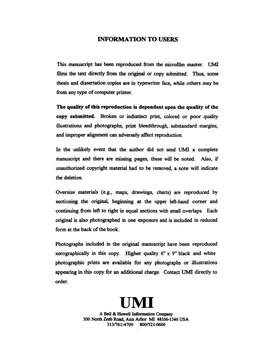| dc.contributor.advisor | Matthews, William, | en_US |
| dc.contributor.author | Schaefer, Jacob F. | en_US |
| dc.date.accessioned | 2013-08-16T12:30:29Z | |
| dc.date.available | 2013-08-16T12:30:29Z | |
| dc.date.issued | 1999 | en_US |
| dc.identifier.uri | https://hdl.handle.net/11244/5788 | |
| dc.description.abstract | The effects of riffles as barriers to movement of stream fish were investigated in large, outdoor artificial streams. Rates of movement of three species of minnows (Cyprinidae) (Campostoma anomalum, Cyprinella venusta and Notropis boops) among pools were measured at four riffle current velocities (0, 15, 30 and 45 cm/s), three thalweg depths (10, 50 and 100 mm), two riffle lengths (183 and 549 cm), and with and without the threat of predation. Overall, results suggest that biotic and abiotic factors in streams influence movement rates and assemblage structure in stream pools. An individual based model of fish movement was developed and tested by comparing predicted distributions to actual distributions of fish in a six pool, five riffle artificial stream. Trials were conducted under three sets of conditions: (1) all riffles had the same thalweg depth and current velocity; (2) when two of the riffles were shallower and faster; and (3) the fifth pool had a predator and the second pool had vegetative cover. Four different variations of the model were run, each with different parameters defining the movement of fish in simulated space. The best fit models suggest that it is important to take into account detailed information on species-specific behaviors, rather than accepting assumptions that species behaviors could be treated as redundant within a family or trophic guild. Movement of 100 Notropis boops and 100 Campostoma anomalum, were tracked over a 28 day period in Brier Creek (Marshall Co., Oklahoma). An individual-based model was used to predict the location of tagged individuals over the course of the experiment. Three different models were used: (1) a model with actual pool size and riffle permeability, (2) a model with all pools the same size and actual riffle permeability, and (3) a model with actual pool size, but all riffles 100% permeable. The model with actual pool size and riffle permeability was the most accurate, and the model with uniform pool size the least accurate. | en_US |
| dc.format.extent | ix, 96 leaves : | en_US |
| dc.subject | Biology, Zoology. | en_US |
| dc.subject | Minnows Oklahoma Marshall County. | en_US |
| dc.subject | Cyprinidae Oklahoma Marshall County. | en_US |
| dc.subject | Fishes Behavior. | en_US |
| dc.subject | Biology, Ecology. | en_US |
| dc.title | Movement by three stream dwelling cyprinids (Notropis boops, Campostoma anomalum, and Cyprinella venusta). | en_US |
| dc.type | Thesis | en_US |
| dc.thesis.degree | Ph.D. | en_US |
| dc.thesis.degreeDiscipline | Department of Biology | en_US |
| dc.note | Source: Dissertation Abstracts International, Volume: 60-04, Section: B, page: 1474. | en_US |
| dc.note | Major Professor: William Matthews. | en_US |
| ou.identifier | (UMI)AAI9925602 | en_US |
| ou.group | College of Arts and Sciences::Department of Biology | |
